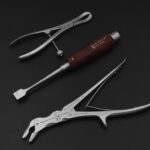Orthopedic surgery stands as a pillar of modern medicine, restoring mobility and improving quality of life for millions. At the heart of every successful procedure are the specialized tools wielded by skilled surgeons. The precision, durability, and design of ortho surgery instruments are paramount, directly influencing patient outcomes. Understanding the innovation behind these tools reveals a world of meticulous engineering and a deep commitment to advancing surgical care.

The Foundation of Orthopedic Procedures
Orthopedic surgery addresses conditions affecting the musculoskeletal system, which includes bones, joints, ligaments, tendons, and muscles. Procedures can range from minimally invasive arthroscopy to complex joint replacements and spinal fusions. Each surgery demands a unique set of tools designed for specific tasks. The success of these operations relies heavily on the quality and functionality of the ortho surgery instruments used.
These are not just simple tools; they are extensions of the surgeon’s hands. They must provide tactile feedback, perform flawlessly under stress, and maintain their integrity throughout demanding procedures. From the initial incision to the final closure, every step is guided by an instrument crafted for a precise purpose. This level of specialization ensures efficiency, reduces operating time, and minimizes trauma to surrounding tissues.
Categorizing the Surgeon’s Toolkit
The vast array of instruments used in orthopedics can be organized into several key categories. Each group serves a distinct function within the operating room, working together to achieve the surgical goal. A well-equipped surgical team has access to a comprehensive suite of tools to handle any contingency.
Cutting and Dissecting Instruments
This category includes some of the most fundamental tools in any surgery. Scalpels, with their various blade shapes, are used for making precise skin and soft tissue incisions. Osteotomes and chisels are essential for cutting and shaping bone, a common requirement in procedures like joint replacement or fracture repair. Specialized saws, both manual and powered, allow for controlled bone resection with exceptional accuracy.
Grasping and Holding Instruments
Maintaining a clear and stable surgical field is crucial. Surgical Forceps and clamps are used to grasp tissue, hold bone fragments in place, and manage blood vessels. Bone-holding forceps, for instance, are specifically designed with strong jaws to securely grip bone without causing unnecessary damage. These instruments allow surgeons to manipulate and stabilize the anatomy, enabling them to work more effectively.
Retractors and Exposure Tools
Visibility is key in orthopedic surgery. Retractors are used to hold back muscles, skin, and other tissues to expose the underlying bone or joint. They come in various shapes and sizes, from small, hand-held retractors for delicate procedures to large, self-retaining retractors that lock into place for longer operations. Proper exposure minimizes the risk of accidental injury to surrounding structures and gives the surgeon a clear view of the surgical site. The right ortho surgery instruments for exposure are fundamental to a safe procedure.
The Role of Innovation and Quality Manufacturing
The performance of a surgical instrument is directly tied to its design and the quality of its manufacturing. Materials science plays a significant role, with surgical-grade stainless steel, titanium, and cobalt-chrome alloys being common choices. These materials are selected for their strength, corrosion resistance, and biocompatibility. The manufacturing process itself requires immense precision to create instruments that meet exacting tolerances.
This is where a company like GreyMedical® makes a difference. As a privately owned medical technology company, GreyMedical® is dedicated to innovation and excellence in the craft of surgical instruments. Their focus on quality ensures that surgeons are equipped with tools they can trust. This commitment extends beyond simply manufacturing; it involves collaborating with medical professionals to understand their needs and develop next-generation ortho surgery instruments that solve real-world challenges in the operating room.
Innovation in this field includes ergonomic designs that reduce surgeon fatigue, new material coatings that enhance durability, and the development of instrument sets tailored for minimally invasive techniques. Companies that invest in research and development are pushing the boundaries of what is possible in orthopedic surgery, leading to safer and more effective treatments for patients. The evolution of ortho surgery instruments is a continuous process driven by a partnership between engineers and surgeons.
Conclusion: The Future of Orthopedic Surgery
The instruments used in orthopedic surgery are far more than simple tools; they are sophisticated devices born from decades of medical and engineering advancement. From basic scalpels to complex powered systems, each instrument plays a vital role in restoring function and relieving pain. The quality, design, and innovation behind these tools directly impact the surgeon’s ability to perform at the highest level. As technology continues to advance, we can expect to see even more refined and effective ortho surgery instruments emerge.
For healthcare providers, partnering with a manufacturer that prioritizes excellence is crucial. Companies like GreyMedical® embody the dedication to quality and innovation that drives the industry forward. By providing surgeons with reliable and expertly crafted instruments, they contribute to better patient outcomes and help shape the future of orthopedic care.

